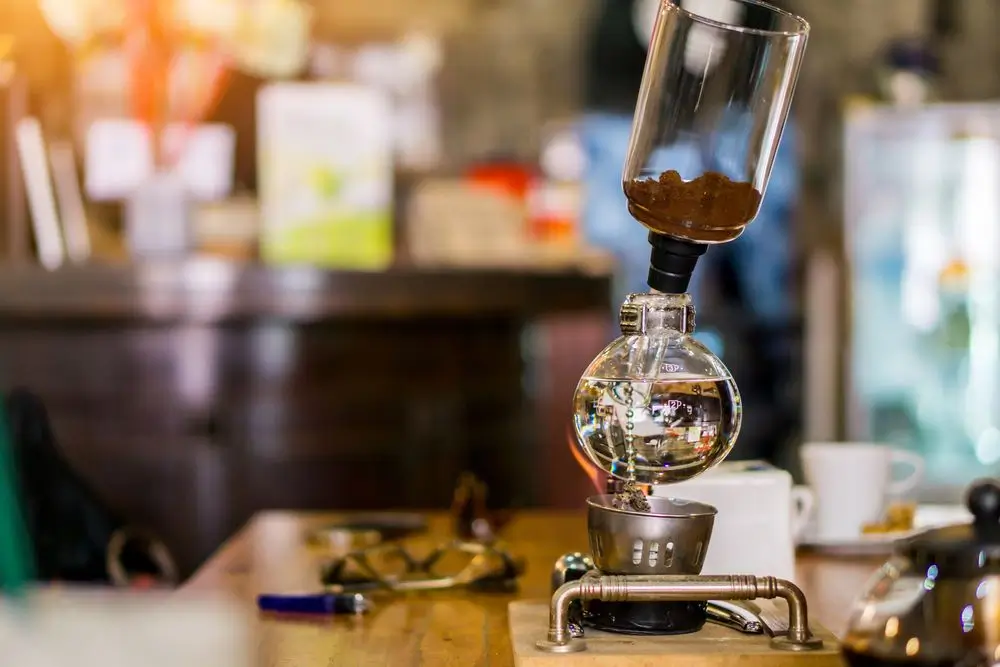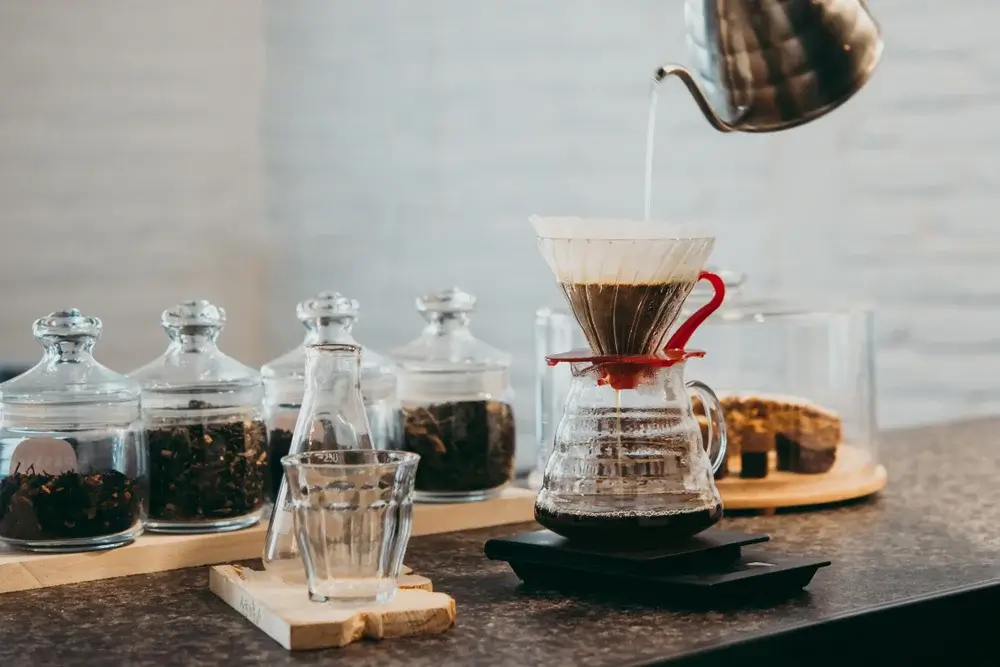Have you ever experienced the delight of savoring a cup of siphon coffee? The rich aroma, the smooth mouthfeel, and the exquisite flavors that dance on your palate – it’s a truly magnificent. Personally, siphon coffee is more than just a beverage; it’s a captivating ritual that I have come to treasure.
There is something special about the process of siphon coffee brewing. From the mesmerizing sight of water ascending through the glass chambers to the anticipation of that first sip, every step holds the promise of a unique and transcendent coffee-drinking experience.
Key Takeaways
- Learn the step-by-step process of siphon coffee brewing, including tips and tricks from experts.
- Discover the importance of selecting high-quality coffee beans and finding the optimal grind size.
- Explore techniques for achieving consistent and delicious siphon coffee brews.
Understanding the Siphon Coffee Brewing Method
What is siphon coffee brewing?
Siphon coffee brewing, also known as vacuum or syphon brewing, is a method that uses vapor pressure and vacuum suction to extract the flavors from coffee grounds. It involves a two-chamber setup, where water is heated and forced into the upper chamber, then filtered down into the lower chamber as it cools, resulting in a clean and flavorful cup of coffee.
The Essential Equipment for brew Siphon Coffee
- A siphon coffee maker, consisting of an upper and lower chamber.
- A heat source, such as a butane burner or an electric stovetop.
- A coffee grinder to grind your beans just before brewing.
- A scale to measure your coffee and water ratios accurately.
- A timer to keep track of brewing time.
How to Brew Siphon Coffee
To get started, assemble the siphon coffee maker by securely attaching the upper and lower chambers. Make sure the seal is tight to prevent any air leakage during the brewing process.

Now, let’s dive into the step-by-step siphon coffee process:
1. Measure and grind your coffee
Begin by measuring out the desired amount of coffee beans. For siphon brewing, a medium to medium-fine grind works best. Aim for a consistency similar to granulated sugar.
2. Add water and heat
Fill the lower chamber of the siphon coffee maker with hot water. The water should be just below boiling point, around 200-205°F (93-96°C). Place the coffee maker on a heat source, such as a stovetop or an open flame.
3. Attach the upper chamber
Carefully attach the upper chamber to the lower chamber, ensuring a tight fit. As the water in the lower chamber heats up, vapor pressure will build, creating a partial vacuum.
4. Add the coffee grounds
Once the water in the lower chamber starts to rise, add the pre-measured coffee grounds to the upper chamber. Give it a gentle stir to ensure all the grounds are saturated.
5. Brew and stir
As the water gets fully heated and starts rising in the upper chamber, the brewing process begins. Allow the coffee to brew for about a minute, and then give it a gentle stir to ensure proper extraction.
6. Remove from heat and let it steep
At this point, remove the siphon coffee maker from the heat source and let it steep for another minute. This will allow the coffee to extract fully and develop its flavors.
7. Separate the chamber
Finally, carefully separate the upper and lower chambers, creating a vacuum that draws the brewed coffee back into the lower chamber.
8. Pour and enjoy
Once the vacuum is formed, pour the freshly brewed siphon coffee into your favorite cup or carafe. Savor the flavors and aromas of this delicate and nuanced brew.
Choosing the Right Beans and Grind Size
When it comes to siphon coffee brewing, selecting the right beans and grind size is essential to achieve a flavorful and satisfying cup of coffee. The quality of your beans will greatly impact the taste and aroma of your brew, while the grind size determines the extraction rate and overall balance of flavors.

Choosing High-Quality Coffee Beans
Start by sourcing high-quality coffee beans for your siphon brew. Look for beans that are freshly roasted and within their optimal flavor window. Specialty coffee roasters often provide detailed information about their beans, including origin, tasting notes, and recommended brewing methods. Opt for single-origin beans or blends that are known to complement the siphon coffee brewing method.
Experiment with different flavor profiles to discover your preference. Lighter roast beans tend to have brighter acidity and more delicate flavors, while medium or dark roast beans offer a bolder and more robust taste. Ultimately, the choice of coffee beans comes down to personal preference, so don’t be afraid to explore and find your perfect match.
Determining the Optimal Grind Size
The grind size is a crucial factor in siphon coffee brewing as it affects the extraction process. A finer grind allows for a slower and more thorough extraction, resulting in a stronger and fuller-bodied cup of coffee. Conversely, a coarser grind produces a quicker extraction, leading to a lighter and more subtle flavor profile.
For siphon coffee brewing, aim for a medium-fine grind size, resembling granulated sugar or sea salt. This grind size offers a balance between extraction speed and flavor complexity. Adjust the grind size based on your brewing time and personal taste preferences. Remember that consistency is key when it comes to grind size, so invest in a reliable grinder to achieve the best results.
Learn: How Long Can Instant Coffee Really Last?
Tips and Tricks for the Perfect Siphon Coffee
As you continue your journey into siphon coffee brewing, here are some additional tips and tricks to enhance your brewing experience and achieve that perfect cup of Joe.

1. Adjust the Coffee-to-Water Ratio
Finding the right balance between coffee and water is crucial for achieving a flavorful siphon coffee. Experiment with different ratios to suit your taste preferences. Start with a 1:15 coffee-to-water ratio and adjust accordingly. Remember, a stronger ratio will result in a bolder brew, while a lighter ratio will offer a milder flavor profile.
2. Experiment with Different Brewing Variables
The siphon brewing method allows for customization and creativity. Explore different brewing variables such as water temperature, immersion time, and grind size to unlock unique flavor profiles. Fine-tune these variables to find the sweet spot that brings out the best in your chosen coffee beans.
“Don’t be afraid to step out of your comfort zone and explore the limitless possibilities of siphon coffee brewing. It’s the perfect canvas for your creativity.”
3. Preheating and Prepping the Siphon
Preheating your siphon brewing equipment plays a significant role in maintaining consistent temperature throughout the brewing process. It helps ensure an even extraction and ultimately affects the taste of your coffee. Additionally, always remember to clean your siphon thoroughly before every brew for a fresh and pure flavor profile.
4. Utilize the Vacuum Effect
The vacuum effect is a unique feature of the siphon brewing method, enhancing the flavor and complexity of your coffee. As the brewed coffee returns to the lower chamber through the filter, the vacuum created intensifies the flavors and aromas. Embrace this science-backed phenomenon and savor the rich and vibrant notes in your cup.
| Tips and Tricks | Benefits |
| Adjust the coffee-to-water ratio | Customize flavor strength |
| Experiment with brewing variables | Unlock unique flavor profiles |
| Preheat and prep the siphon | Maintain consistent temperature |
| Utilize the vacuum effect | Enhance flavors and aroma |
| Practice patience | Master the art of siphon brewing |
Closing Thoughts
Throughout this guide, I have explained the intricacies of siphon coffee brewing and provided a comprehensive tutorial to help you master this unique brewing method. By following the step-by-step process, understanding the equipment, and selecting the right beans and grind size, you can create a remarkable cup of siphon coffee.
However, it’s important to note that mastering siphon coffee brewing requires practice and experimentation. Each brewer, bean, and personal preference will yield different results, so don’t be afraid to adjust variables and make it your own. The true joy of siphon coffee lies in the journey of discovery.
Stay tuned for more coffee brewing guides, recipes, and bean roasts.
FAQs
How do I brew siphon coffee?
To brew siphon coffee, you will need a siphon coffee maker, a heat source, ground coffee, and water. The process involves heating the water in the lower chamber, adding coffee grounds to the upper chamber, and then as the water boils, it creates pressure that pushes the water up into the upper chamber where the coffee steeps. Once the heat is removed, the brewed coffee is drawn back down into the lower chamber through a filter.
What is the best grind size for siphon coffee?
The best grind size for siphon coffee is medium to medium-fine. It should be slightly coarser than espresso but finer than drip coffee. This grind size allows for optimal extraction without clogging the filter or over-extracting the coffee grounds.
How long does it take to brew siphon coffee?
The brewing time can vary depending on factors like water temperature, grind size, and coffee-to-water ratio. On average, it takes about 3 to 4 minutes for the water to rise into the upper chamber and extract the flavors from the coffee grounds. The entire brewing process, from start to finish, usually takes around 5 to 8 minutes.
Can I use any type of coffee beans for siphon coffee?
Yes, you can use any type of coffee beans for siphon coffee. However, it is recommended to choose high-quality beans that are fresh and have been roasted within a few weeks. Different beans will result in unique flavor profiles, so feel free to experiment and find the beans that best suit your taste preferences.


